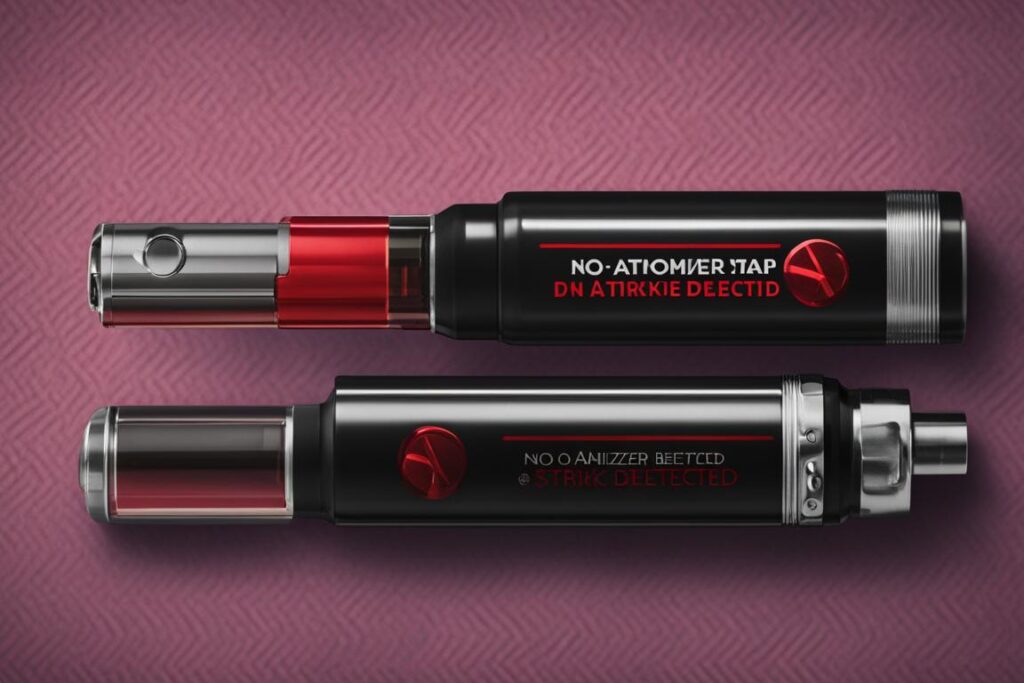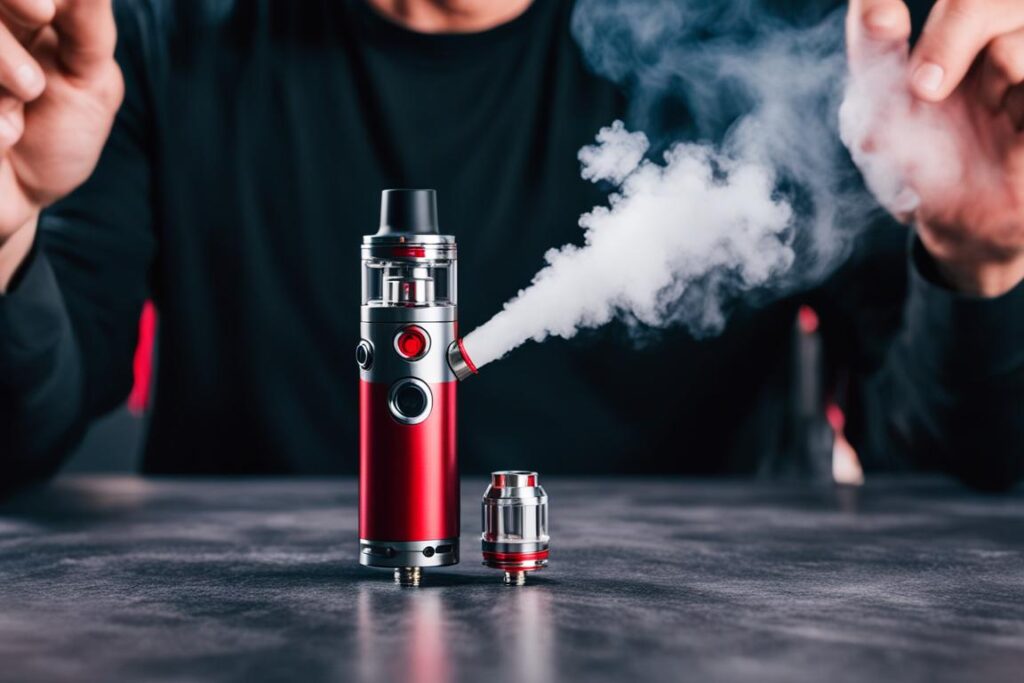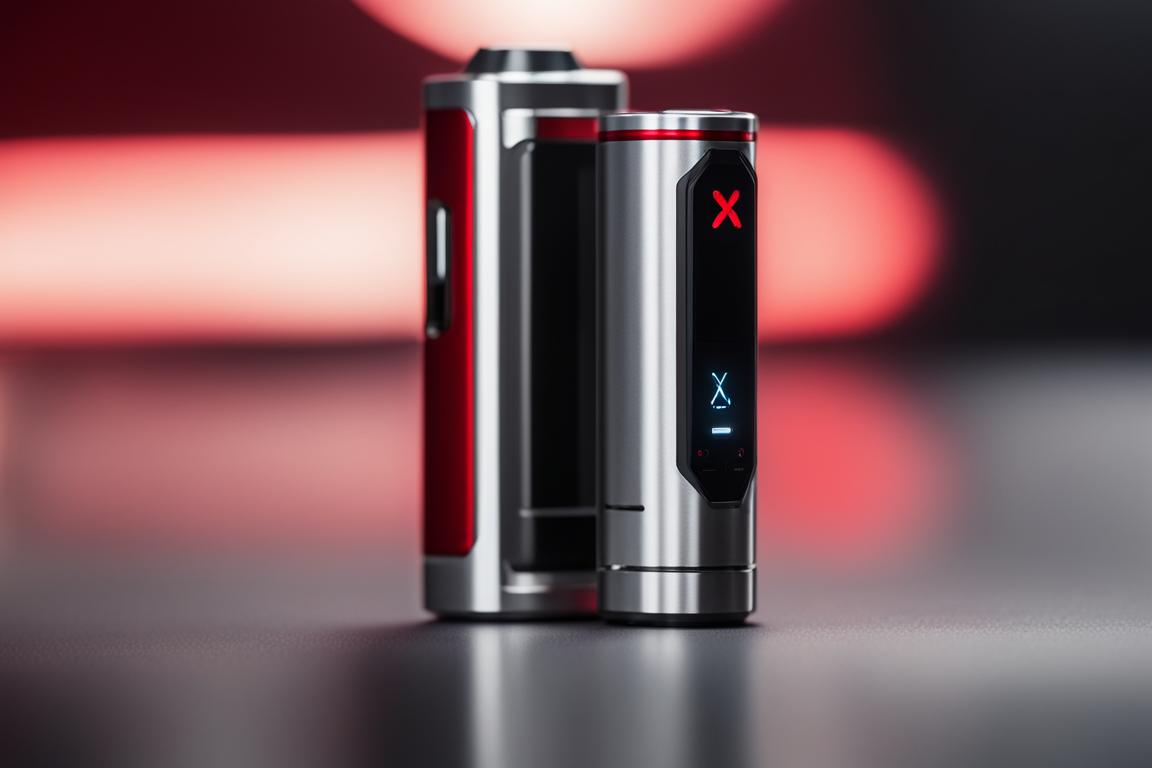Are you experiencing the frustrating “No atomizer” error on your vape device? Don’t worry, we’re here to help! When your vape mod displays this message, it means that the device doesn’t recognize the tank or coil as being connected. This can lead to a disappointing vaping experience, but fear not – we have solutions for you!
The atomizer is a vital component of your vape device responsible for vapor production. It consists of a coil and a wick, which work together to heat the e-liquid and transform it into the delicious vapor you enjoy. However, sometimes things go wrong, and your atomizer might stop working, resulting in the dreaded “No atomizer” error.
So, why does this error message appear? It can happen due to various reasons, including a poor connection between the tank and the mod, damaged components, or a faulty coil. Identifying the cause is crucial in resolving the issue and getting back to enjoying your vaping sessions.
Now that you know what the problem is let’s dive into troubleshooting and fixing the “No atomizer” error. We’ll guide you through the necessary steps to get your vape back in working order. With a little patience and our expert tips, you’ll be vaping again in no time!
Table of Contents
Toggle- What Is the Atomizer in a Vape?
- Why Does the “No Atomizer” Message Appear?
- Troubleshooting and Fixing the “No Atomizer” Error
- Additional Tips for Troubleshooting Atomizer Issues
- Resolving Atomizer Issues in RDAs, RTAs, and RDTAs
- Conclusion
- FAQ
- What does “No atomizer” mean on a vape?
- What is the atomizer in a vape?
- Why does the “No atomizer” message appear?
- How can I troubleshoot and fix the “No atomizer” error?
- Are there any additional tips for troubleshooting atomizer issues?
- How do I resolve atomizer issues in RDAs, RTAs, and RDTAs?
- Can I fix atomizer problems on my own?
- Source Links
Key Takeaways:
- The “No atomizer” error means that your vape device doesn’t recognize the connected tank or coil.
- The atomizer is a crucial component responsible for heating the e-liquid and producing vapor.
- Poor connections, damaged components, or a faulty coil can trigger the “No atomizer” error.
- To troubleshoot the issue, check the connection, clean the contact points, and consider replacing the coil if necessary.
- If the problem persists, consult the manufacturer’s guidance and consider seeking expert assistance.
What Is the Atomizer in a Vape?
The atomizer is a crucial component in a vape device that heats the e-liquid inside the tank to produce vapor. It consists of a coil, which heats up when the vape is activated, and a wick that absorbs the e-liquid and delivers it to the coil. There are different types of atomizers, such as clearomizers and cartomizers, each with its own functioning. Understanding the role of the atomizer helps in troubleshooting atomizer-related issues.
Types of Atomizers
Atomizers come in various types, designed to cater to different vaping preferences and needs. Here are some common types of atomizers:
| Type | Description |
|---|---|
| Clearomizers | Clearomizers are transparent tanks that allow vapers to see the e-liquid level. They generally have replaceable coils and are easy to refill. |
| Cartomizers | Cartomizers combine the tank and atomizer into a single unit. They have a poly-fill material surrounding the atomizer coil, which enhances e-liquid absorption and vapor production. |
| Rebuildable Dripping Atomizers (RDAs) | RDAs require manual dripping of e-liquid directly onto the coil. They offer a customizable vaping experience by allowing users to build and install their own coils. |
| Rebuildable Tank Atomizers (RTAs) | RTAs have a tank section to hold e-liquid, similar to clearomizers, but also provide the option for users to build and install their own coils. |
| Rebuildable Dripping Tank Atomizers (RDTAs) | RDTAs combine the features of RDAs and RTAs, offering a tank section to hold e-liquid while still allowing for dripping onto the coils. |
Each type of atomizer has its advantages and drawbacks, catering to different vaping styles and preferences.
How Atomizers Work
To understand how atomizers work, let’s take a closer look at their key components:
- Coil: The coil is made of resistance wire, typically made of materials like kanthal or nichrome. When the coil is activated, it heats up and vaporizes the e-liquid.
- Wick: The wick is responsible for absorbing e-liquid and delivering it to the coil. Common wick materials include cotton and silica.
- Tank: The tank holds the e-liquid and ensures a constant supply to the coil and wick. It can vary in capacity and design, depending on the type of atomizer.
A properly functioning atomizer ensures the seamless production of flavorful vapor, providing an enjoyable vaping experience.
When a vape device is activated, the coil inside the atomizer heats up, causing the e-liquid to evaporate and turn into vapor. This vapor is then inhaled by the user, creating the sensation and flavor associated with vaping. The atomizer also plays a significant role in regulating the temperature and airflow, allowing vapers to customize their vaping experience.
Understanding the different types of atomizers and how they work is essential for troubleshooting atomizer-related issues and optimizing the vaping experience.
Why Does the “No Atomizer” Message Appear?
The “No atomizer” message on a vape mod can be a frustrating issue for vapers. It indicates that the device is unable to detect the presence of an atomizer or coil. This error can disrupt your vaping experience and leave you wondering what went wrong. Understanding the reasons behind this message is crucial in finding a solution and getting back to enjoying your vape.
Possible Causes of the “No Atomizer” Error
The “No atomizer” error can stem from various factors, including:
- Poor connection between the tank and the mod
- Malfunctioning or damaged components
- A faulty coil
When there is a poor connection between the tank and the mod, the mod fails to recognize the atomizer. This can be due to loose connections, dirty contact points, or incompatible threading. Additionally, a faulty coil can also trigger the “No atomizer” error. Therefore, it’s crucial to thoroughly examine these components to identify the exact cause.
Troubleshooting the “No Atomizer” Error
Resolving the “No atomizer” error may require some troubleshooting steps. Here are a few suggestions to help you fix the issue:
- Check the connection between the tank and the mod, ensuring it is secure and tightly screwed in.
- Clean the contact points on both the tank and the mod using a soft cloth or cotton swab to remove any dirt or e-liquid residue.
- If the problem persists, try replacing the coil with a new one, as a faulty coil can trigger the error message.
- Inspect the 510 pin on the tank and make sure it is not damaged or misaligned. Adjust it if necessary.
- If possible, try using a different tank or mod to determine if the issue lies with a specific device or component.
By following these steps, you can often resolve common causes of the “No atomizer” error and restore your vape to full functionality.

| Common Causes | Possible Solutions |
|---|---|
| Poor connection between tank and mod | Make sure the tank is securely attached to the mod Clean the contact points on both the tank and mod Check for compatible threading between the tank and mod |
| Malfunctioning or damaged components | Inspect all components for physical damage or loose parts Replace any malfunctioning or damaged components |
| Faulty coil | Replace the coil with a new one Ensure the coil is correctly installed and making proper contact with the tank |
By troubleshooting these common causes and taking the appropriate steps, you can successfully address the “No atomizer” error and get back to enjoying a smooth and satisfying vaping experience.
Troubleshooting and Fixing the “No Atomizer” Error
To resolve the “No atomizer” error on your vape, follow these steps:
- Check the connection: Ensure that the tank is securely and properly screwed into the mod. A loose connection can prevent the mod from recognizing the atomizer.
- Clean the contact points: Use a cotton swab or cloth to remove any dirt or e-liquid residue from the contact points on both the tank and the mod. A poor connection caused by debris can trigger the error message.
- Replace the coil: If the issue persists, try replacing the coil with a new one. A faulty coil can also lead to the “No atomizer” error. Be sure to choose a compatible coil for your specific tank.
- Examine the 510 pin: Take a look at the 510 pin on the tank. If it appears loose or out of place, adjust it gently using a small tool. The 510 pin is responsible for establishing the connection between the tank and the mod.
- Try a different tank or mod: If none of the above steps resolve the issue, try using a different tank or mod to determine if the problem lies with a specific component. This can help identify whether the issue is with the device or the atomizer itself.
Following these troubleshooting steps should help you fix the “No atomizer” error and get your vape back to working condition.
Example Troubleshooting Table
| Issue | Cause | Solution |
|---|---|---|
| “No atomizer” error persists | Poor connection between tank and mod | Ensure secure connection and clean contact points |
| “No atomizer” error persists | Faulty coil | Replace coil with a new one |
| “No atomizer” error persists | Loose or misaligned 510 pin | Adjust 510 pin gently |
| “No atomizer” error persists | Component issue with tank or mod | Try using a different tank or mod for troubleshooting |
By following these troubleshooting steps and using the above table as a guide, you can successfully fix the “No atomizer” error on your vape and continue enjoying your vaping experience.
Additional Tips for Troubleshooting Atomizer Issues
In some cases, experiencing the “No atomizer” error on your vape may be caused by factors other than a poor connection or faulty coil. To address this issue effectively, consider the following additional tips:
- Check for physical damage: Inspect both the tank and the mod for any signs of physical damage, such as loose parts or damaged wires. These issues can disrupt the proper functioning of the atomizer and result in the “No atomizer” error.
- Avoid coil contact with the outer chamber: Ensure that the coil is positioned properly and does not make contact with the outer chamber of the tank. If the coil touches the outer chamber, it can lead to problems such as short-circuiting and cause the device to not fire.
- Verify the battery: If you have checked and eliminated any connection or coil-related issues, it is worth checking the battery. Ensure that the battery is fully charged and in good condition. In some cases, a weak or faulty battery can prevent the atomizer from reading or firing properly.
- Consult the manufacturer: Follow the guidance provided by the device manufacturer. Check the user manual or visit the manufacturer’s website for troubleshooting instructions specific to your device model. Following their recommendations can help you address the atomizer problem effectively.
- Seek expert advice: If you have tried all the troubleshooting steps and are still experiencing issues with your atomizer, it may be beneficial to consult an expert. They can provide further guidance and potentially identify any underlying issues that require professional intervention.
Remember, it’s essential to follow the relevant guidelines, both from the manufacturer and industry experts, to ensure a safe and enjoyable vaping experience.
| Problem | Cause | Solution |
|---|---|---|
| Atomizer not reading | Poor connection, damaged coil, or faulty tank | Check and secure the connection, replace the coil or tank if necessary |
| Vape not firing | Short-circuit, low battery, or coil issue | Identify and fix any short-circuit, ensure battery is charged, and replace faulty coil if needed |
| Atomizer problem | Physical damage, improper assembly, or coil misalignment | Inspect for damage, reassemble correctly, and align the coil properly |

Resolving Atomizer Issues in RDAs, RTAs, and RDTAs
Rebuildable atomizers, such as RDAs, RTAs, and RDTAs, offer vapers a customizable and enhanced vaping experience. However, they also come with their own set of potential atomizer issues that can arise. Proper troubleshooting techniques can help resolve these issues and ensure a smooth vaping experience.
One common issue in rebuildable devices is a short atomizer error. To fix this error, it’s crucial to check that the coil is not touching any metal parts other than the designated post holes. When the coil comes into contact with other metal parts, it can cause a short circuit, triggering the error. Additionally, ensuring that the post screws are tightened properly and that there are no breaks or loose wire trimmings in the coil can help prevent short atomizer errors.
Another important troubleshooting step is to check the atomizer resistance. Using a multimeter, measure the resistance of the coil to ensure it falls within the recommended range. If the resistance is too low or too high, it can result in atomizer issues. Adjusting the base of the coil, if applicable to your specific rebuildable atomizer, can also help fine-tune the atomizer resistance.
Resolving Atomizer Issues in Rebuildable Devices – Troubleshooting Steps:
- Check that the coil is not touching any metal parts other than the designated post holes.
- Tighten the post screws and ensure there are no breaks or loose wire trimmings in the coil.
- Measure the atomizer resistance using a multimeter and adjust it if necessary.
- Consult the manufacturer’s instructions for specific guidance on adjusting the base of the coil.
By following these troubleshooting steps, vapers can overcome atomizer issues in RDAs, RTAs, and RDTAs, and enjoy the full potential of their rebuildable devices.
Conclusion
Encountering a “No atomizer” error on your vape can be frustrating, but the good news is that most atomizer issues can be resolved through proper troubleshooting. By following a few simple steps, you can often fix the problem and get back to enjoying a smooth vaping experience.
First, start by checking the connection between your tank and mod. Make sure it is securely screwed in and that there is no dirt or e-liquid residue on the contact points. Cleaning these contact points can often solve the issue.
If the problem persists, try replacing the coil. A faulty coil can trigger the “No atomizer” error, so installing a new one may resolve the issue. It’s also important to consider the specific type of atomizer you are using and follow the manufacturer’s guidance.
If you have tried these troubleshooting steps and the problem still persists, it may be time to consult an expert. They can help diagnose the issue and provide further guidance. Remember, your ultimate goal is to ensure a smooth and enjoyable vaping experience, and with the right troubleshooting techniques, you can overcome most atomizer problems.
FAQ
What does “No atomizer” mean on a vape?
When a vape mod displays a “No atomizer” message, it means that the device does not recognize the tank, specifically the coil or atomizer head, as being connected.
What is the atomizer in a vape?
The atomizer is a crucial component in a vape device that heats the e-liquid inside the tank to produce vapor. It consists of a coil and a wick that deliver the e-liquid to the coil.
Why does the “No atomizer” message appear?
The “No atomizer” message on a vape mod indicates that the device does not detect the presence of an atomizer or coil. This can be caused by a poor connection between the tank and the mod or a faulty coil.
How can I troubleshoot and fix the “No atomizer” error?
To resolve the “No atomizer” error, you can start by checking the connection between the tank and the mod, cleaning the contact points, and replacing the coil if necessary. If the issue persists, further troubleshooting may be needed.
Are there any additional tips for troubleshooting atomizer issues?
Yes, in some cases, other factors such as physical damage or coil contact with the outer chamber can cause atomizer issues. Checking for loose parts or damaged wires and trying a different battery can also help resolve the problem.
How do I resolve atomizer issues in RDAs, RTAs, and RDTAs?
For rebuildable atomizers, it’s important to ensure the coil is not touching any metal parts beyond the designated post holes. Tightening post screws, checking for breaks or loose wire trimmings, and adjusting the base of the coil can also help resolve issues.
Can I fix atomizer problems on my own?
With proper troubleshooting, many atomizer issues can be resolved. However, it’s important to follow manufacturer guidance, consider the specific type of atomizer being used, and consult an expert if needed for assistance.



